Links don't work anymore. Finding a good deal on a dual 315 isn't hard.
-
ICMag with help from Landrace Warden and The Vault is running a NEW contest in November! You can check it here. Prizes are seeds & forum premium access. Come join in!
You are using an out of date browser. It may not display this or other websites correctly.
You should upgrade or use an alternative browser.
You should upgrade or use an alternative browser.
CMH vs LED vs HPS
- Thread starter Gerardbutler79
- Start date
I was in my local grow shop yesterday. It was during the day and slow so I had time to talk to the owner. I mentioned how heated the discussion of LED vs HID gets on this forum. He looked at me and said, "Moot point". The commercial industry drives the market not hobby growers and LEDs are pushing everything else out.
He said many of his vendors don't carry the HID stuff anymore. He didn't have anything but used HID equipment in his store. I wasn't surprised because I had read the same here. What did surprise me is he also said grow tents don't sell anymore either. He used to have bunch of them set up as demos but not anymore. I am from a recreational state so some this is because of that. According to him no one cares about grow tents now because its legal, they just use a room in their home.
Market is moving fast and pretty soon HID will cost more than LED and no one will give a rats ass about which one works better. Price drives every single fucking thing in the US. Most people could give a shit about quality of product. Its a Walmart driven economy. Thats my two cents not his.
He said many of his vendors don't carry the HID stuff anymore. He didn't have anything but used HID equipment in his store. I wasn't surprised because I had read the same here. What did surprise me is he also said grow tents don't sell anymore either. He used to have bunch of them set up as demos but not anymore. I am from a recreational state so some this is because of that. According to him no one cares about grow tents now because its legal, they just use a room in their home.
Market is moving fast and pretty soon HID will cost more than LED and no one will give a rats ass about which one works better. Price drives every single fucking thing in the US. Most people could give a shit about quality of product. Its a Walmart driven economy. Thats my two cents not his.
So we users here are not homegrowers, we are 'industry'!?  No industry pushed me to by a led grow light, it was other users good experience/results and now i experienced it myself, amazing quality and yield.
No industry pushed me to by a led grow light, it was other users good experience/results and now i experienced it myself, amazing quality and yield. 
Buy yourself as much HID bulbs as you want or can get, you won't live forever anyway, so you can grow happy with HID for the rest of your life.
Using a grow tent btw isn't all about avoiding smell, it is also about light reflection, so better effeciency... and not everyone got a separate room for growing cannabis... America btw is not the world, growing is still illegal in most countries of the world.
EDIT: ...and i got the first like from an american! ^^
Buy yourself as much HID bulbs as you want or can get, you won't live forever anyway, so you can grow happy with HID for the rest of your life.
Using a grow tent btw isn't all about avoiding smell, it is also about light reflection, so better effeciency... and not everyone got a separate room for growing cannabis... America btw is not the world, growing is still illegal in most countries of the world.
EDIT: ...and i got the first like from an american! ^^
Last edited:
Cerathule
Well-known member
Well, let's hope it's gonna change here in Germany ASAP and that this causes a major change in how our plant is being apprehended in total Europe...America btw is not the world, growing is still illegal in most countries of the world.
I'm not one to debate a nameless faceless internet person. It pays no dividends. What I will try and do is be more specific with my comments.So we users here are not homegrowers, we are 'industry'!?No industry pushed me to by a led grow light, it was other users good experience/results and now i experienced it myself, amazing quality and yield.
Buy yourself as much HID bulbs as you want or can get, you won't live forever anyway, so you can grow happy with HID for the rest of your life.
Using a grow tent btw isn't all about avoiding smell, it is also about light reflection, so better effeciency... and not everyone got a separate room for growing cannabis... America btw is not the world, growing is still illegal in most countries of the world.
EDIT: ...and i got the first like from an american! ^^
Industry grew the LED market because of the ROI and government kickbacks to up grade to LED, at least in the US and I am willing to make a wager it was the same in every country. It was $$$$$$.
Growers were much slower to jump on board.
HID and MH were also born out of the industrial world and not the growing world. All lighting technology was born out of ways to light factories more efficiently.
I think it would be quite an exaggeration to claim we, the hobby growers, are the industry. We are but a speck on the ass of the lighting sold in the world.
Let me be more specific "the industry" is every factory in the world that has to light its facility. Thats where all the advancements came from. I am 57 yrs old and saw the progression in the industry in lighting from MH to HID then to CMH then to T8 and then T5 and then LED. All to cut down on electrical and or maintenance costs. Growers owe all the technology advancement to the same guys that put green beans in a can, gum in a package or any other manufacture.
I appreciate your input and experience with LEDs. I have nothing against LEDs. The point was your liking them or not liking them is a "moot point" to their growth in the industry. Nothing at all to do with any kind of debate on quality of bud.
Last edited:
Cerathule
Well-known member

An inconvenient truth (about weed)
Federal laws bar cannabis from crossing state lines, driving up the cost — and the emissions — of an industry using indoor grow operations.
"One recent model estimated that Massachusetts’ nascent cannabis industry represented 10 percent of the state’s industrial electricity consumption in 2020. Another study found that growing enough bud for a joint — a gram — consumes as much electricity as driving about 20 miles in a fuel-efficient car. Then there’s the still-vibrant illegal market — where there are no emissions rules whatsoever — that consumes fossil fuels at an even higher rate, often using standalone generators or stealing power from neighbors to fuel their operations."
Ok it's just a model... even if that is exaggerated and the 1% to the total US is more realistic - still, 1% is a big deal for something that is just mostly consumed for recreation. Imagine if every item you handle daily would consume 1% in a states electricity consumption.... render that down to 0.01% and it would be negligible
It was $$$$$$.
now there's a revelation... tell us what isn't for $$$$$$It was $$$$$$.
Gooseman23
Active member
Real growers sharing their experience. Y’all please stop listening to these fake random internet people who probably live in their moms basement and can’t even grow so they just get on here and troll…
Real growers sharing their experience. Y’all please stop listening to these fake random internet people who probably live in their moms basement and can’t even grow so they just get on here and troll…
Thanks for posting this! Their product looks terrific and what an awesome comparison. I do think they are missing some shape/structure they could achieve as well as yield if they got their lights a touch closer, to be harvesting in a few days with those leds further than 24in away is a shame. Regardless, they are crushing and will do better and better as they convert fully to led. Just smoked some recently pulled, fresh led product and it got me stony bologna and tasted insane. Leds ftw!
1.) Yields & Bud Quality
I’m going to start with the factor that many home growers care about the most: yields and bud quality.When you consider the amount of electricity used, modern LED grow lights like the HLG 300 and Electric Sky 300 consistently meet or beat HPS yields in side-by-side grow experiments.
On average, the HLG 300 and Electric Sky 300 LEDs beat HPS for yields (watt for watt)
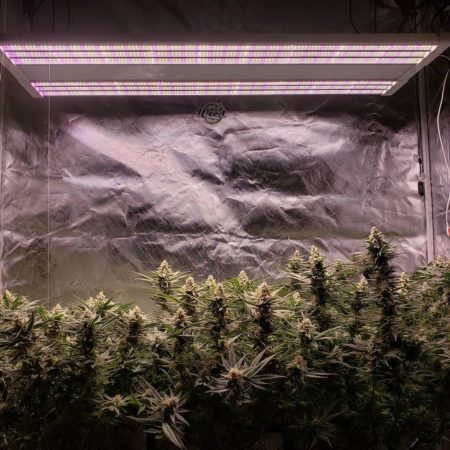
I’ve also found LED bud quality to be the same or better. LEDs often produce more colorful buds and test for higher levels of THC at the lab.
LED bud quality is the same or better (as long as you’re using good LEDs). This bud was grown under the Electric Sky 300 LED
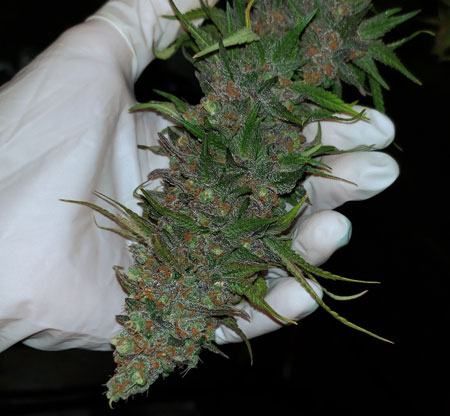
These buds were grown under HLG 300 LEDs
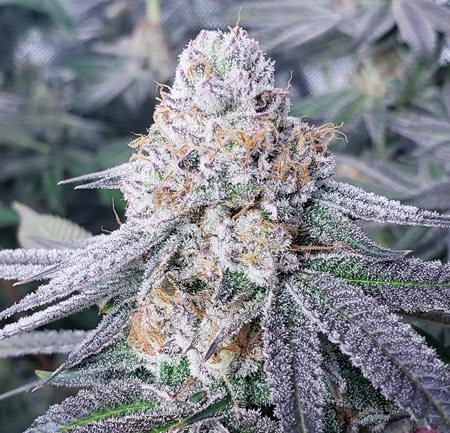
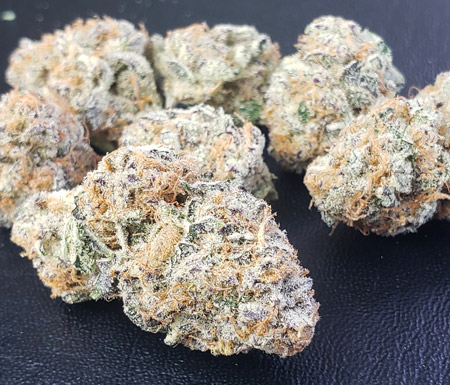
However, I’ve only found this to be true for certain LED models. Older-technology LEDs like ViparSpectra produce overall lower bud quality and yields-per-watt than HPS. If you’re going to go cheap, go HPS. Don’t skimp when buying an LED!
Summary: If you invest in a good LED model, you will be rewarded with exceptional yields and bud quality that match or surpass HPS.
2.) LEDs Run Cooler (Bonus: Plants are More Heat-Resistant)
HPS grow lights are known for bringing on the heat. Their bulbs get so hot that even a quick touch can burn you. Typically you need to find some way to vent heat for any HPS over the 250W size. Ultimately, the extreme heat and intense light from an HPS bulb are out of place in the home, especially compared to a cool-running LED panel.HPS grow lights have earned a reputation for getting hot
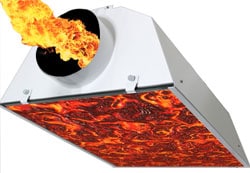
Although older and generic LEDs can get surprisingly hot (which always seemed strange to me since they’re marketed for being cool…), new LEDs live up to the low-heat hype.
For example, a new 300W HLG or Electric Sky 300 LED produces significantly less heat than the equivalent wattage of HPS, CMH, or fluorescent lights. New LEDs also run much cooler than older types of LED technology. For example, a high-quality 300W LED will produce significantly less heat than a crappy 300W LED grow light.
Modern LEDs don’t produce much heat per watt, and models under 300W won’t significantly raise the temperature of a room.
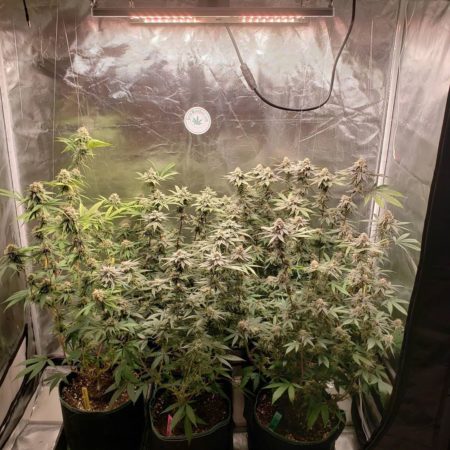
On top of running cooler, LEDs have another advantage for growers that struggle with heat: plants actually prefer warmer temperatures under LEDs. When growing with LEDs, plants grow best around 80°F (26°C), while plants under HPS thrive around 76°F (24°C). That means LEDs produce less heat and plants are more heat-resistant.
Summary: If heat is a challenge, LEDs are hands-down the best choice for cannabis growers.
3.) HPS Companies Stopped Serving Home Growers
HPS manufacturers used to cater to home growers and offered more sizes and options. For example, 250W HPS grow lights were once popular for home growers because they used to cost ~$120 for an all-in-one, produced relatively low heat, used only 250W of electricity, and yielded up to 10 oz of dense buds. Yet a 250W HPS is almost impossible to find anymore, and I haven’t seen an all-in-one model in years.They don’t sell all-in-one 250W HPS grow lights for $120 anymore! I loved these things when I started growing.
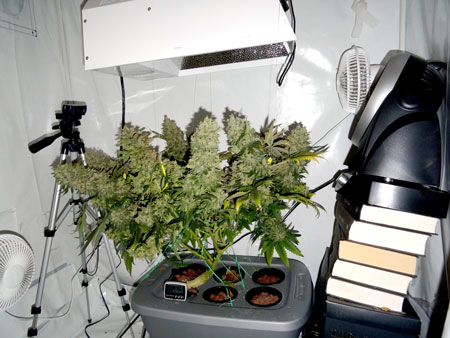
If you’ve been going to hydroponic stores over the last decade, you’ve seen the popularity of various grow lights come and go. Although my local hydro store used to sell 150W, 250W, 400W, 600W, and 1000W HPS lights, they now only offer 600W. This is because the 600W size is the most electrically efficient and therefore the most profitable size for commercial growers.
Why is this happening? HPS technology is mature and HPS grow lights are cheap. Most standard HPS models can be found for under $200 and since the technology isn’t changing, customers expect the prices to go down not up. As a result, there just isn’t much profit in selling HPS lights, especially compared to LEDs which can cost $500 or more per light and take a fraction of that cost to build.
Case in point: The biggest improvement to HPS technology in the last several years is the ceramic HPS (very similar in technology to a CMH, but supposedly better for flowering) yet these are only available in 600W size, and cost an arm and a leg especially with a “specialty” ballast/hood combo. For growers looking to harvest just a few ounces at home, a 600W goes way overboard as far as heat and electricity usage.
HPS technology remains essentially unchanged for decades. Manufacturers have mostly given up trying to sell small HPS lights to hobby-scale growers. Most “new” HPS products are really just expensive variations of a 600W HPS.

Even if you do want a 600W, you often need to buy the ballast, reflector, and bulbs separately to get quality parts. The only all-in-one kits available these days are low-priced generic companies like iPower. These definitely get the job done (when they work), but they’re nothing compared to the solid high-quality HPS options that were once easy to find.
Summary: HPS grow light companies aim their products at commercial growers. If you want a grow light that’s suitable for a home environment, LEDs have more (and better) options.
4.) Convenience
One thing I absolutely love about LEDs is their convenience as far as the grower experience. Unlike HPS, LEDs can be turned on and off instantly as needed. Many models can be dimmed on the go.My eyes are sensitive (protect your eyes under powerful lights!). I used to wear ski goggles when using high-powered lights, but now I just dim the LEDs down to 25% (or quickly turn them off) to check on plants without any discomfort or need for extra eye protection.
#2 is not correct. Although I am an obvious advocate for Leds, they do not create less heat watt for watt. They produce less downward radiant heat. Leds radiate their heat upward. A watt is a watt and every watt generates an equivalent amount of heat. The efficiency lies in the amount of photons produced for far less wattage than a traditional CMH or HPS bulb. When people mention saving 30% on ac costs its because they are throwing up 650-720w leds instead of 1000w de hps lights. There is the savings, its simply due to LESS watts not less heat per watt.1.) Yields & Bud Quality
I’m going to start with the factor that many home growers care about the most: yields and bud quality.
When you consider the amount of electricity used, modern LED grow lights like the HLG 300 and Electric Sky 300 consistently meet or beat HPS yields in side-by-side grow experiments.
On average, the HLG 300 and Electric Sky 300 LEDs beat HPS for yields (watt for watt)

I’ve also found LED bud quality to be the same or better. LEDs often produce more colorful buds and test for higher levels of THC at the lab.
LED bud quality is the same or better (as long as you’re using good LEDs). This bud was grown under the Electric Sky 300 LED

These buds were grown under HLG 300 LEDs


However, I’ve only found this to be true for certain LED models. Older-technology LEDs like ViparSpectra produce overall lower bud quality and yields-per-watt than HPS. If you’re going to go cheap, go HPS. Don’t skimp when buying an LED!
Summary: If you invest in a good LED model, you will be rewarded with exceptional yields and bud quality that match or surpass HPS.
2.) LEDs Run Cooler (Bonus: Plants are More Heat-Resistant)
HPS grow lights are known for bringing on the heat. Their bulbs get so hot that even a quick touch can burn you. Typically you need to find some way to vent heat for any HPS over the 250W size. Ultimately, the extreme heat and intense light from an HPS bulb are out of place in the home, especially compared to a cool-running LED panel.
HPS grow lights have earned a reputation for getting hot

Although older and generic LEDs can get surprisingly hot (which always seemed strange to me since they’re marketed for being cool…), new LEDs live up to the low-heat hype.
For example, a new 300W HLG or Electric Sky 300 LED produces significantly less heat than the equivalent wattage of HPS, CMH, or fluorescent lights. New LEDs also run much cooler than older types of LED technology. For example, a high-quality 300W LED will produce significantly less heat than a crappy 300W LED grow light.
Modern LEDs don’t produce much heat per watt, and models under 300W won’t significantly raise the temperature of a room.

On top of running cooler, LEDs have another advantage for growers that struggle with heat: plants actually prefer warmer temperatures under LEDs. When growing with LEDs, plants grow best around 80°F (26°C), while plants under HPS thrive around 76°F (24°C). That means LEDs produce less heat and plants are more heat-resistant.
Summary: If heat is a challenge, LEDs are hands-down the best choice for cannabis growers.
3.) HPS Companies Stopped Serving Home Growers
HPS manufacturers used to cater to home growers and offered more sizes and options. For example, 250W HPS grow lights were once popular for home growers because they used to cost ~$120 for an all-in-one, produced relatively low heat, used only 250W of electricity, and yielded up to 10 oz of dense buds. Yet a 250W HPS is almost impossible to find anymore, and I haven’t seen an all-in-one model in years.
They don’t sell all-in-one 250W HPS grow lights for $120 anymore! I loved these things when I started growing.

If you’ve been going to hydroponic stores over the last decade, you’ve seen the popularity of various grow lights come and go. Although my local hydro store used to sell 150W, 250W, 400W, 600W, and 1000W HPS lights, they now only offer 600W. This is because the 600W size is the most electrically efficient and therefore the most profitable size for commercial growers.
Why is this happening? HPS technology is mature and HPS grow lights are cheap. Most standard HPS models can be found for under $200 and since the technology isn’t changing, customers expect the prices to go down not up. As a result, there just isn’t much profit in selling HPS lights, especially compared to LEDs which can cost $500 or more per light and take a fraction of that cost to build.
Case in point: The biggest improvement to HPS technology in the last several years is the ceramic HPS (very similar in technology to a CMH, but supposedly better for flowering) yet these are only available in 600W size, and cost an arm and a leg especially with a “specialty” ballast/hood combo. For growers looking to harvest just a few ounces at home, a 600W goes way overboard as far as heat and electricity usage.
HPS technology remains essentially unchanged for decades. Manufacturers have mostly given up trying to sell small HPS lights to hobby-scale growers. Most “new” HPS products are really just expensive variations of a 600W HPS.

Even if you do want a 600W, you often need to buy the ballast, reflector, and bulbs separately to get quality parts. The only all-in-one kits available these days are low-priced generic companies like iPower. These definitely get the job done (when they work), but they’re nothing compared to the solid high-quality HPS options that were once easy to find.
Summary: HPS grow light companies aim their products at commercial growers. If you want a grow light that’s suitable for a home environment, LEDs have more (and better) options.
4.) Convenience
One thing I absolutely love about LEDs is their convenience as far as the grower experience. Unlike HPS, LEDs can be turned on and off instantly as needed. Many models can be dimmed on the go.
My eyes are sensitive (protect your eyes under powerful lights!). I used to wear ski goggles when using high-powered lights, but now I just dim the LEDs down to 25% (or quickly turn them off) to check on plants without any discomfort or need for extra eye protection.
Cerathule
Well-known member
100% agree. It's just less wattage used but still, a 700W energy relased inside a closed tents needs some air exchange or this energy will mount up. And of course, one needs also to constantly deliver new CO2 into a growroom, especially crucial during the lights on phase.#2 is not correct. Although I am an obvious advocate for Leds, they do not create less heat watt for watt. They produce less downward radiant heat. Leds radiate their heat upward. A watt is a watt and every watt generates an equivalent amount of heat. The efficiency lies in the amount of photons produced for far less wattage than a traditional CMH or HPS bulb. When people mention saving 30% on ac costs its because they are throwing up 650-720w leds instead of 1000w de hps lights. There is the savings, its simply due to LESS watts not less heat per watt.
One thing to add is that from all the photons released in a growchamber, only about 1-3% actually make it into the process of photosynthesis (which conserves teh harnessed energy in the construction of chemical compounds). Then the majority of the rest of the remaining 97-99% of the photons will be absorbed to cause increased "heat".
I'm not sure LED flowers are more heat-resistant as HPS buds. Sure, the LED has a way higher blue, but HPS more radiant heat, it's such a generalized wording here used so hard to identify what was ment precisely. What I could say for sure is that sunlight grown leaves will be better to deal with excess light or leaf temperature, as high PPFD + lots of FRL causes some physiological changes in leafwidth and chloroplasts number, plus the suns broad and excessive UV/blue cause way higher buildup of "sunscreen-/filterpigments".
Mudraya
Active member
i think this has a lot more to do with amazon than anything else. you can buy decent tents at 50-20% the price they sell them for in overpriced grow stores. infact amazon is likely the cause for much of his angle.What did surprise me is he also said grow tents don't sell anymore either. He used to have bunch of them set up as demos but not anymore. I am from a recreational state so some this is because of that. According to him no one cares about grow tents now because its legal, they just use a room in their home.
Yes, love LED. Run the ES 180 v3 in a 36x20” and it absolutely KILLS!!!1.) Yields & Bud Quality
I’m going to start with the factor that many home growers care about the most: yields and bud quality.
When you consider the amount of electricity used, modern LED grow lights like the HLG 300 and Electric Sky 300 consistently meet or beat HPS yields in side-by-side grow experiments.
On average, the HLG 300 and Electric Sky 300 LEDs beat HPS for yields (watt for watt)

I’ve also found LED bud quality to be the same or better. LEDs often produce more colorful buds and test for higher levels of THC at the lab.
LED bud quality is the same or better (as long as you’re using good LEDs). This bud was grown under the Electric Sky 300 LED

These buds were grown under HLG 300 LEDs


However, I’ve only found this to be true for certain LED models. Older-technology LEDs like ViparSpectra produce overall lower bud quality and yields-per-watt than HPS. If you’re going to go cheap, go HPS. Don’t skimp when buying an LED!
Summary: If you invest in a good LED model, you will be rewarded with exceptional yields and bud quality that match or surpass HPS.
2.) LEDs Run Cooler (Bonus: Plants are More Heat-Resistant)
HPS grow lights are known for bringing on the heat. Their bulbs get so hot that even a quick touch can burn you. Typically you need to find some way to vent heat for any HPS over the 250W size. Ultimately, the extreme heat and intense light from an HPS bulb are out of place in the home, especially compared to a cool-running LED panel.
HPS grow lights have earned a reputation for getting hot

Although older and generic LEDs can get surprisingly hot (which always seemed strange to me since they’re marketed for being cool…), new LEDs live up to the low-heat hype.
For example, a new 300W HLG or Electric Sky 300 LED produces significantly less heat than the equivalent wattage of HPS, CMH, or fluorescent lights. New LEDs also run much cooler than older types of LED technology. For example, a high-quality 300W LED will produce significantly less heat than a crappy 300W LED grow light.
Modern LEDs don’t produce much heat per watt, and models under 300W won’t significantly raise the temperature of a room.

On top of running cooler, LEDs have another advantage for growers that struggle with heat: plants actually prefer warmer temperatures under LEDs. When growing with LEDs, plants grow best around 80°F (26°C), while plants under HPS thrive around 76°F (24°C). That means LEDs produce less heat and plants are more heat-resistant.
Summary: If heat is a challenge, LEDs are hands-down the best choice for cannabis growers.
3.) HPS Companies Stopped Serving Home Growers
HPS manufacturers used to cater to home growers and offered more sizes and options. For example, 250W HPS grow lights were once popular for home growers because they used to cost ~$120 for an all-in-one, produced relatively low heat, used only 250W of electricity, and yielded up to 10 oz of dense buds. Yet a 250W HPS is almost impossible to find anymore, and I haven’t seen an all-in-one model in years.
They don’t sell all-in-one 250W HPS grow lights for $120 anymore! I loved these things when I started growing.

If you’ve been going to hydroponic stores over the last decade, you’ve seen the popularity of various grow lights come and go. Although my local hydro store used to sell 150W, 250W, 400W, 600W, and 1000W HPS lights, they now only offer 600W. This is because the 600W size is the most electrically efficient and therefore the most profitable size for commercial growers.
Why is this happening? HPS technology is mature and HPS grow lights are cheap. Most standard HPS models can be found for under $200 and since the technology isn’t changing, customers expect the prices to go down not up. As a result, there just isn’t much profit in selling HPS lights, especially compared to LEDs which can cost $500 or more per light and take a fraction of that cost to build.
Case in point: The biggest improvement to HPS technology in the last several years is the ceramic HPS (very similar in technology to a CMH, but supposedly better for flowering) yet these are only available in 600W size, and cost an arm and a leg especially with a “specialty” ballast/hood combo. For growers looking to harvest just a few ounces at home, a 600W goes way overboard as far as heat and electricity usage.
HPS technology remains essentially unchanged for decades. Manufacturers have mostly given up trying to sell small HPS lights to hobby-scale growers. Most “new” HPS products are really just expensive variations of a 600W HPS.

Even if you do want a 600W, you often need to buy the ballast, reflector, and bulbs separately to get quality parts. The only all-in-one kits available these days are low-priced generic companies like iPower. These definitely get the job done (when they work), but they’re nothing compared to the solid high-quality HPS options that were once easy to find.
Summary: HPS grow light companies aim their products at commercial growers. If you want a grow light that’s suitable for a home environment, LEDs have more (and better) options.
4.) Convenience
One thing I absolutely love about LEDs is their convenience as far as the grower experience. Unlike HPS, LEDs can be turned on and off instantly as needed. Many models can be dimmed on the go.
My eyes are sensitive (protect your eyes under powerful lights!). I used to wear ski goggles when using high-powered lights, but now I just dim the LEDs down to 25% (or quickly turn them off) to check on plants without any discomfort or need for extra eye protection.
This thread doesn't even cover the lights I use- CFL's. I can grow more/better weeds with some CFL bulbs than I ever could with LED's. I tried Mars Hydro LED's for three years, and it was nothing but a disappointing mess. I switched back to my big 42 watt CFL's in my grow tent, and now I'm rocking again!
Hiddenjems
Well-known member
This. I can get 5x10 tents for $150.i think this has a lot more to do with amazon than anything else. you can buy decent tents at 50-20% the price they sell them for in overpriced grow stores. infact amazon is likely the cause for much of his angle.
I’m running Cmh in my 3x3 for the first time. I’m in flower and so far am very impressed! I like the heat from the lamp. It seems to me warm leaf surfaces plus cool water on the roots allows for really rapid growth and nutrient uptake.

My overcrowded tent with some ssh Catpiss and afghanis under a 315cmh.

My overcrowded tent with some ssh Catpiss and afghanis under a 315cmh.
One watt of electricity produces 3.4 BTUs of heat, 10 watts of power equates to 34 BTUs of heat output for each square foot of room area. The more current used will add more heat.
HID wastes roughly 30% of the energy from infrared
LEDs generally don't produce heat in the form of infrared.
Heat is produced within the LED device itself, due to the inefficiency of the semiconductor processes that generate light. The ambient temperature and the drive current both affect the junction temperature of LEDs. The junction temperature affects the lifetime of the LED. Unlike other light sources, LEDs don’t tend to fail catastrophically. LEDs emit light directionally over 180 degrees vs HID at 360 Degrees. This means there are far fewer losses from the need to redirect or reflect light.
HID LIFESPAN 25,000 hours
LED LIFESPAN 100,000+
LED are far superior in efficacy. I still believe using both HID/LED is the best choice. This is based on my current grow room. I don't use any controlled AC or humidity, just swap coolers and dehumidifiers. If I ran a fully automated system my opinions could change.
My veg space is 100% CMH. I'll never swap to LED out there. I need that heat in cooler months. I run into issues in winter from the cold temps. In summer everything is happy.
HID wastes roughly 30% of the energy from infrared
LEDs generally don't produce heat in the form of infrared.
Heat is produced within the LED device itself, due to the inefficiency of the semiconductor processes that generate light. The ambient temperature and the drive current both affect the junction temperature of LEDs. The junction temperature affects the lifetime of the LED. Unlike other light sources, LEDs don’t tend to fail catastrophically. LEDs emit light directionally over 180 degrees vs HID at 360 Degrees. This means there are far fewer losses from the need to redirect or reflect light.
HID LIFESPAN 25,000 hours
LED LIFESPAN 100,000+
LED are far superior in efficacy. I still believe using both HID/LED is the best choice. This is based on my current grow room. I don't use any controlled AC or humidity, just swap coolers and dehumidifiers. If I ran a fully automated system my opinions could change.
My veg space is 100% CMH. I'll never swap to LED out there. I need that heat in cooler months. I run into issues in winter from the cold temps. In summer everything is happy.
Last edited:



